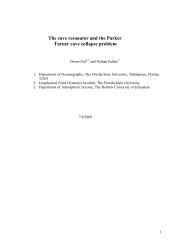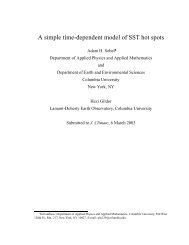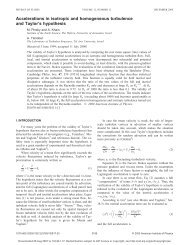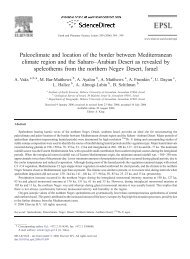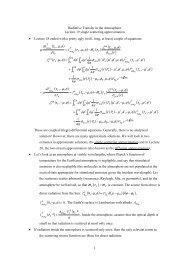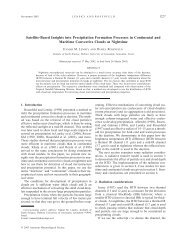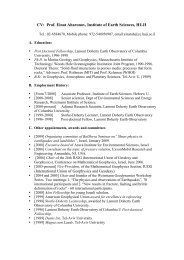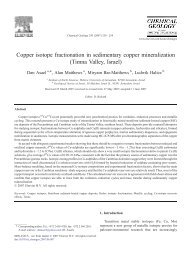Effects of photorespiration, the cytochrome pathway, and the ...
Effects of photorespiration, the cytochrome pathway, and the ...
Effects of photorespiration, the cytochrome pathway, and the ...
- No tags were found...
Create successful ePaper yourself
Turn your PDF publications into a flip-book with our unique Google optimized e-Paper software.
30 - 2 ANGERT ET AL.: BIOLOGICAL EFFECTS ON THREE O 2 ISOTOPESThe substrate water in leaves is enriched in 17 O <strong>and</strong> 18 Othrough evapotranspiration [Dongmann, 1974]. As a result,terrestrial photosyn<strong>the</strong>sis produces O 2 that, on average, isenriched in <strong>the</strong>se heavy isotopes. In both marine <strong>and</strong>terrestrial systems, <strong>the</strong> major cause <strong>of</strong> <strong>the</strong> heavy isotopeenrichment is preferential removal <strong>of</strong> 16 O (over 17 O <strong>and</strong>18 O) by biological uptake mechanisms [Lane <strong>and</strong> Dole,1956]. This preferential removal is mass-dependent <strong>and</strong> <strong>the</strong>relative increase in 17 O/ 16 O is about half (0.52) <strong>of</strong> <strong>the</strong>relative increase in 18 O/ 16 O (Figure 1). In addition toevapotranspiration <strong>and</strong> biological uptake, atmospheric O 2is also affected by photochemical reactions in <strong>the</strong> stratosphere[Luz et al., 1999]. These reactions preferentiallytransfer 17 O <strong>and</strong> 18 O from O 2 to CO 2 in a mass-independentway. Hence, in <strong>the</strong>se reactions <strong>the</strong> ratio <strong>of</strong> <strong>the</strong> increase in17 O/ 16 O over 18 O/ 16 O in CO 2 is equal to 1 or larger[Lämmerzahl et al., 2002; Thiemens, 1999]. As a result,O 2 becomes mass-independently depleted in <strong>the</strong> heavyisotopes [Bender et al., 1994]. At <strong>the</strong> surface <strong>of</strong> <strong>the</strong> Earth,<strong>the</strong> 17 O depletion <strong>of</strong> atmospheric O 2 is removed byexchange through photosyn<strong>the</strong>sis <strong>and</strong> uptake. Therefore,<strong>the</strong> net result is depletion in 17 O <strong>of</strong> atmospheric O 2 incomparison to O 2 affected by biological uptake alone(Figure 1). The magnitude <strong>of</strong> this depletion depends on<strong>the</strong> ratio <strong>of</strong> production <strong>of</strong> 17 O depleted O 2 in <strong>the</strong> stratosphere,<strong>and</strong> its destruction by biological cycling. Thus, pastvariations in <strong>the</strong> 17 O depletion can be used to infer changesin global biological productivity.[4] In order to apply this approach, it is necessary that <strong>the</strong>relationship between 17 O/ 16 O <strong>and</strong> 18 O/ 16 O to be known withgreat accuracy. However, <strong>the</strong> triple isotope relationships indifferent physical-chemical mass-dependent processes,varies slightly about 0.52 [Luz <strong>and</strong> Barkan, 2000; Matsuhisaet al., 1978; Young et al., 2002]. If this is also <strong>the</strong> casefor O 2 consumption by different biological mechanisms,<strong>the</strong>n a change in <strong>the</strong> ratio <strong>of</strong> uptake by <strong>the</strong> different <strong>pathway</strong>swill result in variations in <strong>the</strong> magnitude <strong>of</strong> <strong>the</strong> 17 Odepletion. As a consequence, past variations in this parameterwill be misinterpreted.[5] In interpretations <strong>of</strong> variations in <strong>the</strong> Dole Effect it isusually assumed that <strong>the</strong> major driving force is changes in<strong>the</strong> terrestrial to marine production rate (terrestrial producedO 2 is heavier than marine produced, because <strong>of</strong> <strong>the</strong> enrichment<strong>of</strong> leaf water in evapotranspiration). An impliedassumption is that <strong>the</strong> enrichment due to biological uptakeremains constant. In <strong>the</strong> present paper, we explore <strong>the</strong>possibility that time variations in Dole Effect were alsoaffected by changes in <strong>the</strong> relative rates <strong>of</strong> O 2 uptake bydifferent biological mechanisms, that have different fractionationsassociated with <strong>the</strong>m. Consumption (or uptake) <strong>of</strong>O 2 in plants occurs via four mechanisms: ordinary respirationthrough <strong>the</strong> <strong>cytochrome</strong> oxidase <strong>pathway</strong> (COX), respirationby <strong>the</strong> alternative oxidase <strong>pathway</strong> (AOX), Mehlerreaction, <strong>and</strong> <strong>photorespiration</strong>. The first two processes takeplace in light as well as in dark conditions, while <strong>the</strong> lattertwo occur only under illumination. In addition, O 2 diffusionin air precedes biological uptake in some cases. The discriminationagainst 18 O associated with <strong>the</strong> AOX (28%)isstronger than <strong>the</strong> discrimination associated with o<strong>the</strong>r mechanisms(COX 18%, Mehler 15%, <strong>photorespiration</strong> Figure 1. Schematic plot (not to scale) <strong>of</strong> 17 O <strong>and</strong> 18 Orelative to 16 O variations. Oxygen is produced by photosyn<strong>the</strong>sis<strong>and</strong> it is fractionated by biological uptake in amass-dependent way, <strong>and</strong> by stratospheric photochemistryin a mass-independent way. The balance between <strong>the</strong>se twotypes <strong>of</strong> fractionation control <strong>the</strong> triple isotopic composition<strong>of</strong> atmospheric O 2 .22%). Hence, an increase in <strong>the</strong> proportion <strong>of</strong> O 2 uptake byAOX will significantly intensify <strong>the</strong> Dole Effect.[6] To improve <strong>the</strong> interpretation <strong>of</strong> past variations in <strong>the</strong>triple O 2 isotopes <strong>and</strong> <strong>the</strong> Dole Effect, we have investigated<strong>the</strong> effects <strong>of</strong> biological mechanisms in controlled laboratoryexperiments. In one set <strong>of</strong> experiments, we studiedtriple isotope variations due to uptake alone by COX <strong>and</strong>AOX, <strong>and</strong> due to removal by diffusion. In a second set <strong>of</strong>experiments, conducted in an airtight terrarium, we analyzed<strong>the</strong> combined effects <strong>of</strong> production <strong>and</strong> consumptionby both dark <strong>and</strong> light reactions in steady state betweenphotosyn<strong>the</strong>sis <strong>and</strong> uptake.2. Triple Isotope Systematics2.1. Terminology[7] Atmospheric O 2 is depleted in 17 O due to stratosphericreactions. Hence, O 2 that is produced by photosyn<strong>the</strong>siswill have 17 O excess with respect to atmospheric O 2 .This 17 O excess was formulated in previous papers [Luz <strong>and</strong>Barkan, 2000; Luz et al., 1999] as D 17 O=d 17 O 0.521 d 18 O. However, this definition is somewhat problematicsince it contains a linear approximation to <strong>the</strong> mass-dependentfractionation, <strong>and</strong> because <strong>the</strong> parameter 0.521 (thatrepresents mass-dependent processes) depends on <strong>the</strong>choice <strong>of</strong> reference material. Here, we follow <strong>the</strong> suggestion<strong>of</strong> Miller [2002] for a new definition <strong>of</strong> <strong>the</strong> 17 O excess thatis free <strong>of</strong> <strong>the</strong>se problems:17 R18 R17 D ln C ln : ð1Þ17R18 ref R ref



